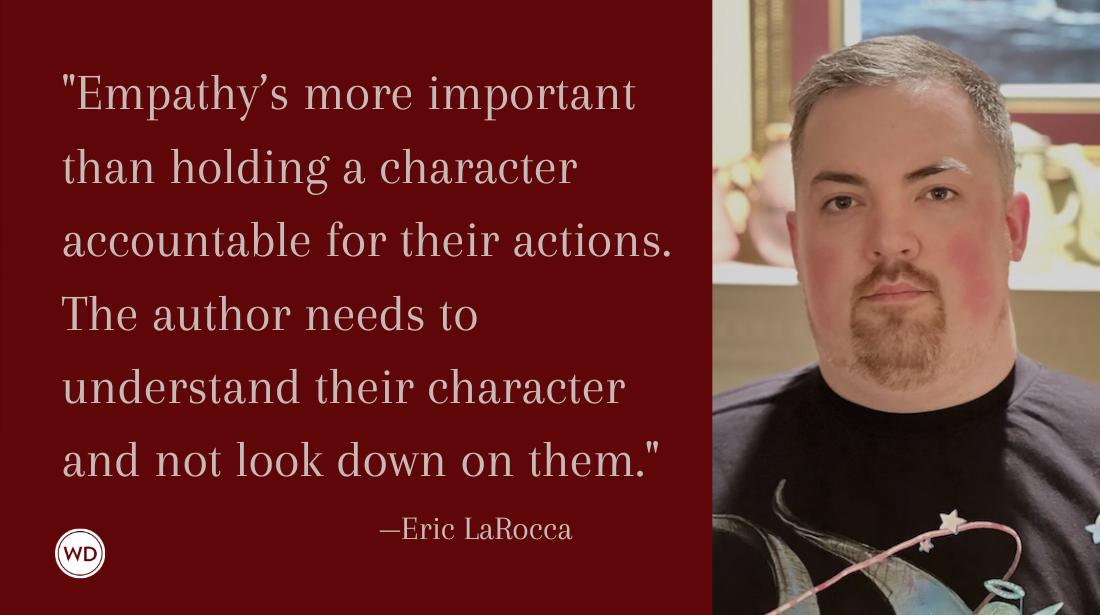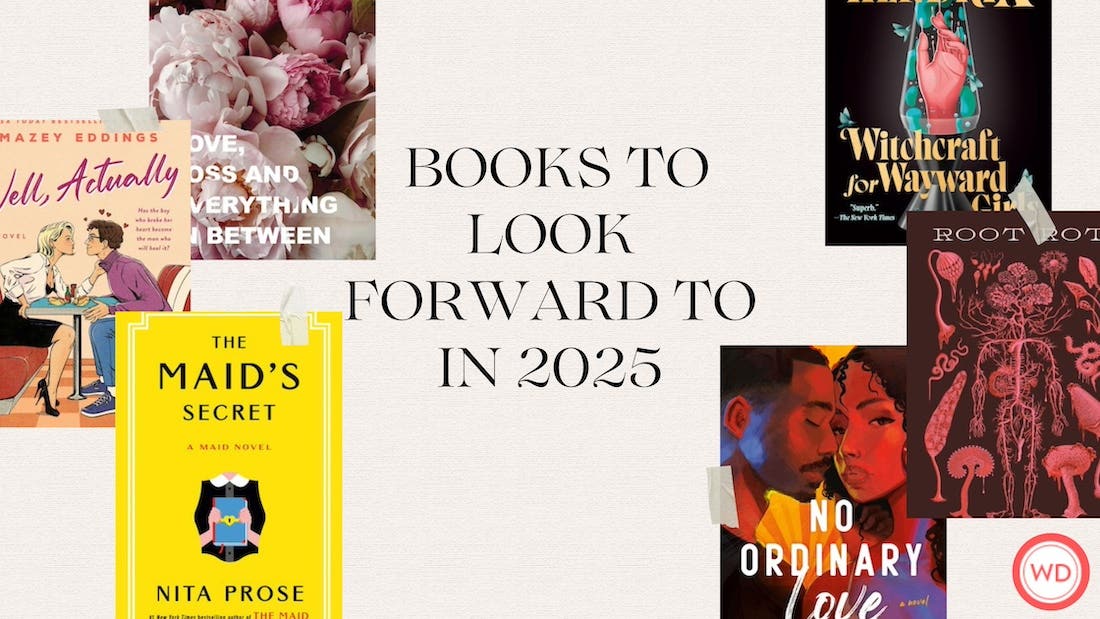7 Critical Steps to Crafting a Compelling Villain
Writing compelling, three-dimensional villains requires knowing their weak spots as well as what compels them toward their wrongdoing. Here, author Hunter Liguore shares seven critical steps to crafting a compelling villain.
Creating a masterful villain comes with a responsibility to present the reader with someone they can root for to be thwarted—the very opposite of the hero, who they are rooting for to succeed. It’s the act of creating a living mirror, where one person acts solely for the benefit of others (hero), while the other chooses to act for their own selfish gain (villain).
Often, the hero’s work is done in the full light of day, unobscured, while the villain works through the harboring of secrets, executed and shrouded in darkness, even figuratively. At the heart of a good villain, we find all the very best traits of being human gone wrong—the more human a writer can portray a villain, the more engaging to the reader, who wants to believe justice will triumph.
What follows are seven critical steps to ensuring your villain will win over your readers.
The Encounter
The initial step of creating a compelling villain begins with a chance meeting with some new person, item, or information that is viewed as an inevitable solution to the villain’s dilemma. In most cases, they have tried to find an answer to their woe through the honest route and have failed.
Feeling desperate, with little choice, they see this lucky encounter as the hand of fate turning favor in their direction, even if it means heading down the road of dishonesty. The villain reasons that it must be the way forward, or else they would not have made the encounter.
At this embryonic junction, it’s as if the world has been turned upside down—and it has! If they were to remain the hero of their story, they would turn back. But they don’t. Instead, they succumb to this new venture that shirks societal morals and virtues.
The Opportunity
A wise and cunning villain will often see possibility where others don’t. Once they’ve made the initial encounter, very quickly they will see a rare, once-in-a-lifetime opportunity present itself that will provide an immediate benefit. Viewed as the answer to all their problems, this choice establishes in their mindset a clear ingenuity. Mentally, they begin to plan … and dream of what bounty or paradise lies ahead. Once they have begun, they can’t stop and will continue to take every advantage presented, each one digging them deeper into the dark side of villainy.
A perfect example of this occurs in Tod Browning’s Freaks (1932) when Cleopatra (Olga Baclanova), a carnival star in debt has a chance encounter with Hans (Harry Earles), who is very smitten with her, despite the fact she is “big,” or that he has a girlfriend. Cleo sees Hans’ interest as an opportunity to exploit. She soon receives a gift of flowers from Hans, followed by a basket of fruit. She’s not interested in the fruit, which prompts Hans to gift her a gold bracelet instead, which she pawns for cash.
But it’s not enough! She persuades Hans to give her a necklace worth twice as much as the bracelet. And she keeps going, seeing Hans as her opportunity for wealth, sure she can flirt her way to an expensive coat next! Every step of the way, Cleo thinks only of herself, despite the growing sentiment in the community that she’s taking advantage of Hans, the hero we’re rooting for to thwart this villain!
The Dastardly Decision
A time comes in every villain’s life when they have to make a second decision of whether or not they will continue to live dishonestly, or if they will push their luck to see if they can reach a new height or vista that they had never previously seen for themselves. They reason that things are going good, but can be—with a bit more time and ingenuity—even better!
Fueled by self-interest and gain, with little moral conscience, they see the possibility of having reached a long-held dream that they never believed possible. But it’s here now, within grasp, if they will just take the next step.
In Freaks, Cleo’s dastardly decision occurs when she learns that Hans has inherited a large sum of money. She reasons that the gifts are great, but having all his money would give her the life she’s always wanted. Her decision is dastardly in that she not only plans to marry Hans, but to also kill him, whereby the whole sum of money will be hers! Hans is innocent to her true intentions—and even when his former girlfriend warns him, Hans just sees it as jealousy and an obstacle to his own happiness.
The Human Regret
Villains are at their core very human, and it’s their ability to show us the dark side of our emotions and capabilities that makes them compelling to witness. Through the villain, we realize that the hero is always one choice away from joining the villain—but tested, time and again, they remain true, with purity of heart, reminding the audience that goodness can prevail.
In the same respect, however, the villain is also one decision from returning to the world of light, wherein self-interest is traded for the benefit of others: The audience roots for them to change, to make a better choice. They stay to find out: Will they, or won’t they?
Human regret usually turns up right before the villain can fulfill their grand plan, giving them one last opportunity to fix things. Ultimately, as writers, we’re giving them the opportunity to make amends, to return to the land of purity, and start over, rather than plow through to the point-of-no-return. It usually evokes the truest vulnerability of what it means to be human, and a dilemma in how willing and far they’ll go to get what they want.
The moment is often marked with either the villain remarking, what have I done?—or someone close to them—and they are usually blindsided by the turn of events, that they felt was so in their control just a moment ago. Regretting what they’ve done, even momentarily, the villain has another decision to make…
The Full Commitment
Since the villain has revealed their true capability, usually of a heartless, uncaring manner for the welfare of others, they often have the proof they need to make the full commitment to their master plan. In other words, even if they had a little regret, they’ve tarnished any semblance of their old “good” self, pushing them to finish what they’ve started.
In a way, they feel forgiveness or redemption are no longer in reach or possible for them to reclaim. Thus, they make a full commitment, even when they know that the way forward will most likely end in failure, or worse, their own death!
In Freaks, Cleo’s regret is going through with her marriage to Hans, which cuts her off from her old life for good, as she becomes part of the sideshow community, one where she is the odd one, the “freak,” essentially. Unable to turn back, she has no choice but to continue with her plan to kill Hans, to be free of the marriage and have all his money. As she begins poisoning Hans, still innocent of her deceit, she has every opportunity to stop and choose again—to have compassion for Hans, who believes she is taking care of him during a great sickness. It is the dark hour for the hero, yet the brightest for the villain, because they are fully committed, and there is nothing to stop them; they will succeed!
The Great Fall
With the villain’s victory in sight, ever committed, they usually have just one more thing to do to fulfill their goal. It is the very last choice they’ll make—do it and it usually suggests they have become the essence of evil, the absolute opposite of purity. But there is no regret, nor a grand debate at this stage. They’ve accepted this new fate—it is actually the audience that believes there is still hope, that there is one micro-chance that they will change!
For Cleo, she holds the last spoonful of poison out for Hans and then takes it back—it looks like she will have a change of heart, that she will choose to do the right thing and stop this madness. But the spoon goes into Hans’ mouth and soon, he will die…
This is the Great Fall for the villain because they have completely obliterated any aspect of empathy for anyone else. Rather than see the consequences of their singular action, and how it might hurt or cause disorder and torment to others, they can only see how it will benefit themselves. Their moral compass is equally squashed: This becomes their new identity, the foundation of memory that they will return to, a type of origin story, of how they became a villain.
The Final Consequence
The type of story you’re writing will determine if there are any consequences for the villain’s actions. Unlawful villains are brought to justice, allowing the law to prevail. Sometimes, like in the case of Cleo, retribution is fierce and unforgiving. (There are actually two endings, neither for the weak at heart!)
The writer becomes judge, jury, and verdict, deciding the fate of the villain, which often takes place at night and over by morning, ushering in a new day, symbolic for the restoration of purity and light. The hero prevails. Natural order resumes, even though it's now changed.
And if a villain has averted capture … Well, there is still a sense that order has been restored, even if only for a little while …
Hunter Liguore is the award-winning author of Whole World Inside Nan’s Soup. She teaches writing at Lesley University’s MFA program. Learn more at hunterliguore.org.








